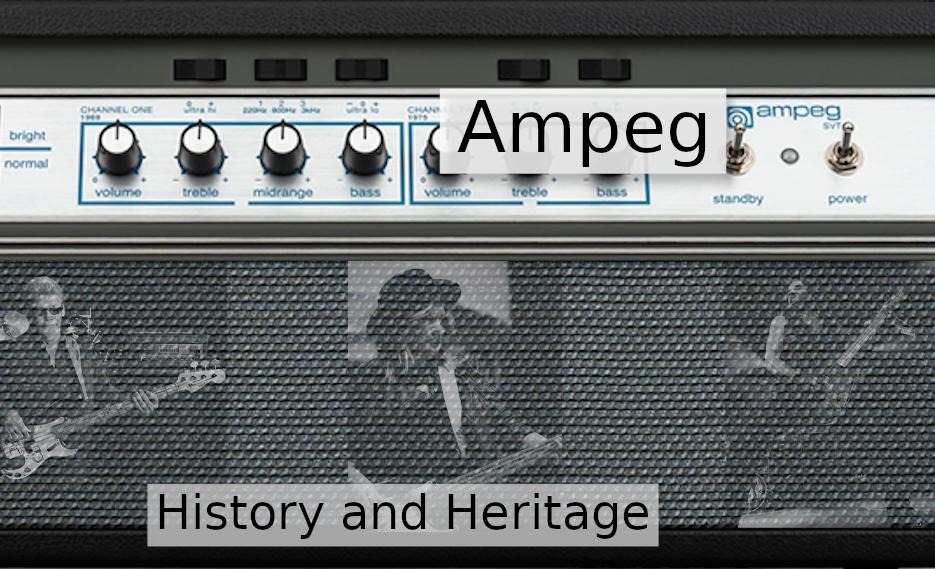

There are few names as synonymous with bass amplification as Ampeg. The company's impact on the sound of popular music continues to reverberate around the world; from recording and rehearsal studios to the biggest stadium stages, Ampeg amplification with its rich harmonic content gives every bass player the smoothest of tones to the heaviest of deliveries.
Wind the clock back to 1946 – the earliest incarnation of what would become Ampeg began life in Linden, New Jersey as 'Michaels-Hull Electronic Labs', courtesy of the partnership created by Charles Everett Hull and Stanley Michaels. But the company would undergo a name change after Hull created a pickup for his upright bass by placing a transducer inside the body of the instrument via a support peg. Hull's wife coined the name 'Ampeg' from this new 'amplified peg' and thus, Ampeg was born.
Michaels departed in 1948, after which Hull relocated the company to 42nd Street in Manhattan and having developed connections with musicians in the vibrant jazz scene of New York, as awareness of the company's products increased, the company became 'The Ampeg Company, Inc.' in 1959. The following year would see the company's first major step in creating a product that was not only a sure-fire success but shaped the course of popular music for decades to come!
The B-15 'Portaflex' combo amplifier was launched in 1960 and was quickly adopted by upright bass players who could now hear themselves, but even more so by the ever-increasing number of electric bass players. Over the decade, it would become the bass amplifier by which others were judged – and in many respects, this is still the case. 'The Motown Sound' is as much attributable to the bass performances of James Jamerson and the ever-presence of a B-15 in the Detroit-based 'Hitsville U.S.A.' studios as any other component. Lovingly referred to as 'The Fliptop' due to the ability to invert the top of the chassis on which the amplifier is situated, the fact the amplifier can be re-inverted for quick setups, easy transportation and valve protection made it an instant success. The tones it offered meant it became the 'de-facto' standard for bass amplification in recording studios around the world and unsurprisingly, it would go on to become the most recorded bass amplifier in history.
As the 60s progressed, and musical fashions came and went, rock music quickly became a dominant musical force. As touring bands played ever-sizeable venues, the needs of the guitarist were being addressed but the bass player was increasingly being left behind. Amplification manufacturers were giving guitarists substantial amplification that could be over-driven and distorted without compromising output power; subsequently, bassists struggled to keep up. Enter Ampeg's Super Valve Technology – or as it will be known for ever-more, the Ampeg SVT!
Utilising 14 valves to generate 300 watts of power was a seismic shift, creating what Ampeg's Chief Engineer Roger Cox called “the biggest, nastiest bass amplifier the world has ever seen!”. The SVT, in tandem with the new 8x10-inch speaker cabinet, affectionately termed 'The Fridge', answered the requirements of touring bassists and even more so for those bass players who were trailblazing across stadium and festival stages, where their booty-shaking bass-lines could finally be heard as well as felt.
It should come as no surprise that The Rolling Stones in their prime would provide the ideal testbed for this new technology. Rocking up for their US tour in 1969, their amplification fell flat when they discovered their amps weren't designed to handle US voltages. Effectively saving the day, and the tour, Rich Mandella of Ampeg was ideally placed to go on the road for the tour's duration, giving the amplifiers and cabinets a thorough workout. Such was the sonic display, both Ronnie Wood and Keith Richards would opt to use the SVT rig as well, and would continue to do so for many subsequent tours.
Although Ampeg have produced guitar amplification and instruments along the way, it is their iconic bass amplification that has defined the company and sealed their standing in the world of popular music. Musical trends come and go, or come full circle, yet the Ampeg brand continues to be the first choice amplification for recording and touring bassists. Whether you're looking for traditional looks and performance courtesy of the Heritage and Classic Series, the broader feature set of the SVT Pro Series, the vintage tones of the Portaflex range or lightweight Neodymium-based speaker enclosures for improved comfort and portability, the full product range offers multiple, flexible solutions. With a rich musical heritage to draw upon, and an equally rich choice of solid-state or valve-based technologies to choose from, the demands of the modern bassist have been addressed to provide the ideal tools to create a bass performance you'll be proud of. Ampeg – the amplifier of legends...and long may it remain so!